
Within the Orchidaceae, Hormidium was originally a subgenus of the genus Epidendrum, but was later raised to a full genus. It is now considered not to be distinct from the genus Prosthechea, of which it is a synonym. Most of the species of Hormidium have been transferred to Prosthechea, although others are now classified in Encyclia, Epidendrum, Homalopetalum, and Lepanthes.

Encyclia tampensis or Tampa butterfly orchid is a species of flowering plant in the orchid family, subfamily Epidendroideae.

Epidendrum compressum is a species of orchid in the genus Epidendrum from wet montane forests of Trinidad, Venezuela, Colombia, Ecuador, Peru and Bolivia.

Epidendrum paniculatum is a species of orchid in the genus Epidendrum.

Epidendrum pseudepidendrum is a species of orchid native to Costa Rica and Panama. The upright canes, which can reach 5 ft., bear paniculate inflorescences which can re-bloom for several years. According to Reichenbach, the strange name is the result of first being named Pseudepidendrum spectabile, before being moved to Epidendrum.

Encyclia adenocaula is a species of epiphytic orchid of light purple flowers, native to forests in Mexico.

Encyclia alata is a species of orchid.

Encyclia ambigua is a species of orchid.

Encyclia ceratistes, also known as Epidendrum ramonense or frosted rain, is a species of orchid.
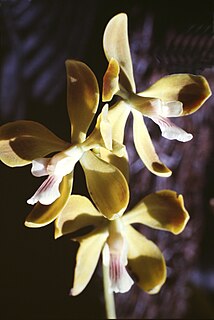
Encyclia diurna is a species of orchid.
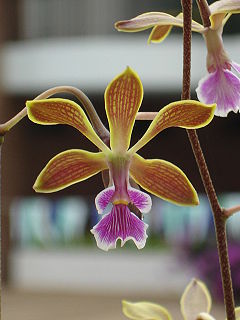
Encyclia oncidioides is a species of orchid. The diploid chromosome number of E. oncidioides has been determined as 2n = 40.

Epidendrum ibaguense is a species of epiphytic orchid of the genus Epidendrum which occurs in Trinidad, French Guyana, Venezuela, Colombia and Northern Brazil.
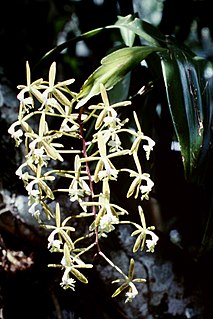
John Lindley published Epidendrum subg. Spathium of the Orchidaceae. According to Lindley's diagnosis, the E. subg. Spathium is recognizable by is sympodial habit with individual stems being slender and covered by the bases of the distichous leaves, by the lip of the flower being adnate to the column to its apex, and by the inflorescence emerging from at least one spathe, similar to nearly all members of the genus Cattleya as understood in the year 2000. Reichenbach recognized 52 species in this subgenus, of which Kew accepts 48 :
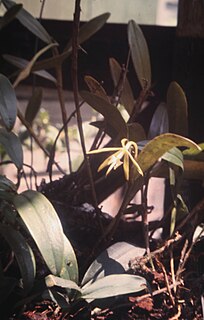
Epidendrum subsect. UmbellataRchb.f. (1861) is a subsection of section E. sect. PlanifoliaRchb.f. (1861) of subgenus E. subg. EpidendrumLindl. (1841) of the genus Epidendrum of the Orchidaceae. Plants of E. subsect. Umbellata differ from the other subsections of E. sect. Planifolia by producing inflorescences which are umbel-like. In 1861, Reichenbach recognized ten species in this subsection. Of these, nine are recognized with the same names by Kew :
Epidendrum subsect. PaniculataRchb.f. 1861 is a subsection of section E. sect. Planifolia of subgenus E. subgen. Epidendrum of the genus Epidendrum of the Orchidaceae. Plants of E. subsect. Paniculata differ from the other subsections of E. sect. Planifolia by producing paniculate inflorescences. In 1861, Reichenbach recognized eighteen species in this subsection. From this group, Kew recognizes seventeen species :
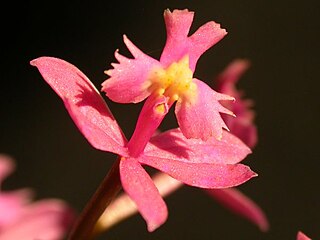
Epidendrum subsect. Tuberculata is a subsection of the section Schistochila of the subgenus AmphiglottiumLindl. of the genus Epidendrum of the Orchidaceae. This subsection differs from the subsection Integra in that the margins of the trilobate lip are dentate or lacerate. This subsection differes from the subsection Carinata by possessing a callus, or tubercule on the midlobe of the lip. In 1861, Reichenbach recognized 22 species in this subsection. Many, but not all, have since been brought into synonymy with Epidendrum secundum.

Epidendrum sect. PolycladiaRchb.f. 1861 is a section of the Subgenus E. subg. AmphiglottiumLindl. of the Genus Epidendrum of the Orchidaceae. This plants in this section differ from the plants in the other sections of E. subg. Amphiglottium by having truly paniculate inflorescences: the section E. sect. Holochila is characterized by racemose inflorescences and an undivided lip, and the section E. sect. Schistochila is characterized by racemose inflorescences and a lobed lip.
Epidendrum sect. Holochila Rchb.f. 1861 is a section of subgenus Epidendrum subg. Amphiglottium of the Orchidaceae. It differs from section E. sect. Polycladia by bearing inflorescences that are racemes, not panicles. It differs from section E. sect. Schistochila by having a lip with no lobes. Like the other sections of E. subg. Amphiglottium, plants of E. sect. Holochila exhibit slender stems covered with close imbricating sheaths which do not swell to form pseudobulbs, and terminal inflorescences covered at the base with close imbricating sheaths but without spathes.
Epidendrum subgenus Aulizeum was raised from sectional status by Lindley in 1853. According to the Latin diagnosis, this taxon included those species of Epidendrum with a multi-lobate lip adnate to the column, with pseudobulbous stems, with the flowers sessile or born on racemes or panicles. In his further English description, Lindley stated that the species in this taxon have a horn-like stem which is only leafy at the end, and racemose inflorescences. In 1861, Reichenbach listed 32 species in this subgenus; of these, Kew recognizes 31 as separate species.

Encyclia advena is a species of epiphytic orchid, native to Atlantic forests in Brazil.
















